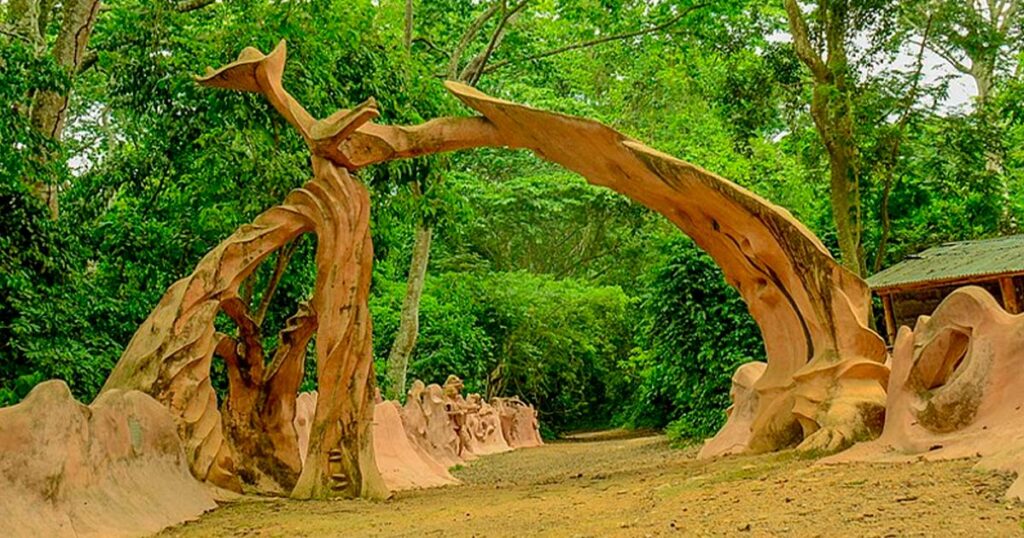In the 15th century, deep within the Osun-Osogbo Sacred Grove, an exiled group of Yoruba settlers sought refuge along the banks of the Osun River. Their leader, a powerful priestess, is said to have encountered Osun, a goddess who promised them prosperity and protection if they honoured her and preserved the forest around her sacred waters.
Today, the grove remains one of the last virgin forests in southern Nigeria, safeguarded by spiritual reverence and ritual.
Across Africa, forests, rivers, and mountains are more than natural landscapes; they are sacred spaces deeply embedded in religious and cultural traditions. From the Osun-Osogbo Sacred Grove in Nigeria to Kenya’s Kaya Forests and South Africa’s Lake Fundudzi, ancient spiritual beliefs have helped conserve biodiversity for centuries.
But as urbanisation, climate change, and modernisation advance, can spiritual conservation efforts withstand these pressures?
Indigenous African traditions hold that nature is infused with divine presence. The Osun-Osogbo Sacred Grove, dedicated to the Yoruba goddess Osun, has remained untouched by deforestation because of its religious significance.
Similarly, the Kaya Forests of Kenya, protected by the Mijikenda people, contain shrines and burial grounds that render them inviolable. In South Africa, the Venda people revere Lake Fundudzi as sacred, prohibiting indiscriminate fishing or pollution.
These traditions function as de facto environmental policies, preserving unique ecosystems where governmental regulations often fail.
In Ethiopia, the Tigray Orthodox Church has safeguarded thousands of hectares of forestland around its churches, creating green sanctuaries amid widespread deforestation. In Ghana, locals protect the Boabeng-Fiema Monkey Sanctuary because they believe the monkeys are messengers of the gods.
In Uganda, the Baganda people safeguard the forests around the Nnamasole Baagalayaze Tombs, believing them to be the resting places of ancestral spirits. These faith-driven conservation efforts illustrate the power of spiritual reverence in protecting nature beyond legislative measures.
Christianity, one of Africa’s dominant religions, has also contributed to environmental stewardship. The Catholic Church in Kenya, through organisations like the Catholic Youth Network for Environmental Sustainability in Africa, has promoted afforestation projects and climate advocacy.
In Nigeria, Catholic priests have denounced oil pollution and demanded environmental justice in the Niger Delta.
Islam, another major faith on the continent, emphasises the sanctity of nature. The Islamic Foundation for Ecology and Environmental Sciences has worked with Muslim communities in Tanzania and Sudan to promote sustainable land use based on Islamic teachings. Some mosques now incorporate environmental messages into Friday sermons, reinforcing the idea that conservation is a religious duty.
Newer spiritual movements are also contributing to conservation. Eckankar, which has gained followers across West and Central Africa, teaches a connection between nature and spirituality.
In Ghana, its practitioners promote ethical living, which includes environmental preservation. Rastafarian communities, particularly in Ethiopia and South Africa, advocate for organic farming and eco-conscious living as part of their commitment to harmony with nature.
Despite these efforts, faith-based conservation faces challenges. Urban expansion encroaches on sacred lands, forests shrink, and rivers become polluted. Traditional belief systems have weakened, with younger generations prioritising economic growth over ancestral customs. Political and corporate interests further complicate conservation.
Nonetheless, faith-based conservation endures. In Ethiopia, Orthodox Christian churches maintain sacred forests, offering biodiversity hotspots in otherwise deforested regions. Faith leaders across Africa increasingly join climate activism, recognising their spiritual influence as a tool to mobilise millions.
This perspective on conservation extends beyond policy and science, highlighting the role of belief systems in protecting Africa’s natural heritage. By integrating faith with environmental advocacy, Africa can preserve its sacred landscapes not just as a matter of ecological necessity but as a sacred duty.
In the 15th century, Yoruba settlers in the Osun-Osogbo Sacred Grove in Nigeria encountered the goddess Osun, who promised them prosperity and protection in exchange for preserving the surrounding forest. This site, among others across Africa, highlights how sacred spaces are deeply integrated into cultural and religious traditions, conserving biodiversity historically unprotected by legislation. For instance, the Kaya Forests in Kenya and Lake Fundudzi in South Africa are protected due to their spiritual significance, showing how indigenous beliefs serve as informal environmental policies.
These faith-driven conservation efforts persist despite urbanization, climate change, and modernization challenges. Religions like Christianity and Islam are increasingly involved in environmental stewardship, with the Catholic Church in Kenya supporting reforestation projects and Islamic teachings promoting sustainable land use. Newer movements such as Eckankar and Rastafarianism emphasize nature's spiritual connection and eco-friendly practices. Despite obstacles, faith-based actions endure, with leaders recognizing the spiritual influence as crucial for mobilizing and protecting Africa's natural heritage beyond traditional policy measures. Integrating faith with environmental advocacy ensures the preservation of sacred landscapes as both an ecological necessity and a sacred duty.






